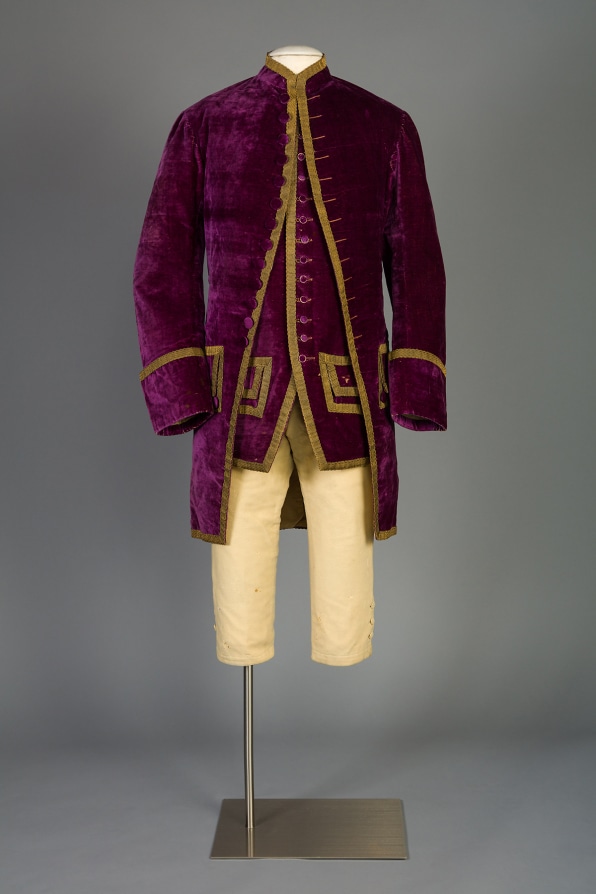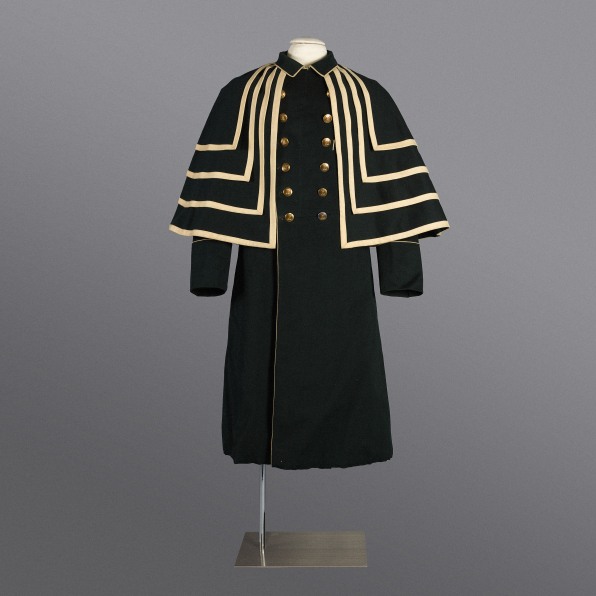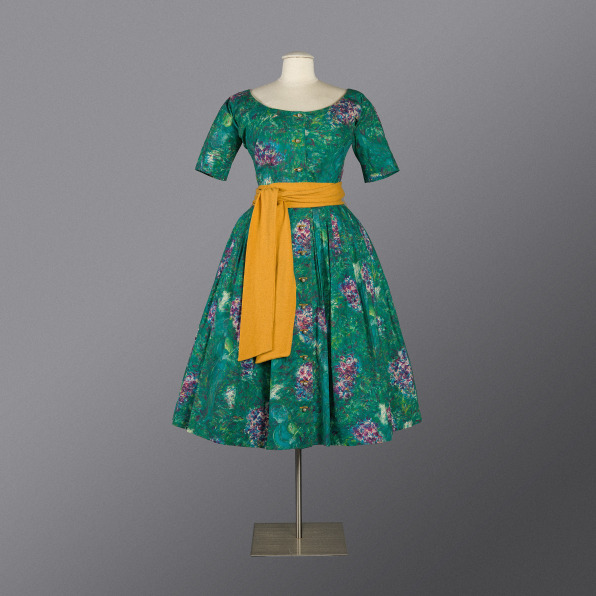The Maryland Historical Society opens ‘Spectrum of Fashion’ exhibit – Fast Company
The hidden history of American fashion, in four garments
A new exhibit featuring 300 years of American garments sheds light on people whose stories are rarely written in the history books.

Though not trained as a curator or historian, Williams did her best to catalog the garments she found, and for decades patiently placed them in boxes and organized them by date and style. She lined drawers to organize stray buttons and lace. On 4 x 5 cards, she recorded details about each item, slowly documenting a collection of 12,000 individual outfits and costumes. She didn’t realize it at the time, but she was preserving one of the largest collections of American garments in the country.
Williams passed away on October 1, 1993 at the age of 77, but her legacy lives on through her work with these clothes. Over the last four years, an army of volunteers and historians have worked to preserve them further and get them ready to display at a new exhibit at the Society’s headquarters in Baltimore. Starting on October 6, a collection of 100 garments will be open to the public at a new exhibit called Spectrum of Fashion, which will run until October 2020.
The clothes offer a glimpse into aspects of fashion history that don’t get recorded in books. While most of the garments Williams found in the Pratt House belonged to the wealthy and famous, they were often created by people who were far less privileged. Many were sewn by enterprising women who had no other source of income, whose legacies have been largely lost to time. Many were purchased using income generated from slave labor. In this sense, Williams’s collection sheds light on the power structures that upheld American society.
I sat down with Allie Tolman, the curator of this exhibit, to discuss what previously hidden stories these clothes bring to light. Here are five pieces that speak to this often untold history.
The “Unidentified Slave Man”

There are a few garments worn by slaves in this collection. “They tended to be made of lower-quality materials,” says Tolman. “And it didn’t make sense for most people to hold on to their slave’s old clothes.”
But there are some rare exceptions in the collection. Among the fancy gowns, there are a few liveries that would have been worn by household slaves and servants. Liveries began as a European tradition among aristocratic families, but prominent American families would outfit their enslaved workers in these expensive uniforms to display their financial stature. Most liveries have not survived because they were working clothes that would eventually get worn out from use, but there are a couple in this collection.
Take for instance this ornate purple livery that dates back to between 1840 and 1849. Made from imported materials, like silk velvet and wool, it would have been worn by a slave whose name was not recorded. Tolman says that only highly visible slaves would have had nice garments; those working behind the scenes would have likely worn low-quality clothes, perhaps made from scraps or old garments belonging to their owners. However, a lot of effort was invested in the garments worn by slaves who would be seen by the slaveowner’s friends and community. They would have been outfitted in clothes deliberately designed to showcase the family’s wealth. This particular livery incorporates 18th-century clothing details, like breeches and gold gilt trims. This antiquated style was a way to ensure that no one mistook an enslaved person as a freeman or freewoman, who would have chosen to dress in a contemporary style.
In that light, this embellished garment is evidence of how slavery and oppression were woven into the fabric of 19th-century America.
The Millionaire Designer Who Faded From History

In the collection, we see examples of female seamstresses who had a great influence on fashion and design, but who are generally unknown to the public. This is partly because women’s lives are not as well-documented as men’s, and partly because these seamstresses often did not have official businesses. Tolman says one woman, for instance, began sewing when she was widowed and worked out of her daughter’s house.
Tolman explains that sewing was an important skill to many women. “Women learned how to sew as children, and they often sewed together as a communal activity,” she says. “But highly skilled seamstresses could turn to sewing when they needed to make money.”
But there were other seamstresses who had large, thriving businesses. One of them was Carlotta Mary “Lottie” Barton, who owned a business in Baltimore in the late 1800s, creating elaborate dresses for Maryland’s rich and famous. “She was probably a millionaire,” says Tolman. “She was so successful that she hired 50 workers in her store, and yet very few people have heard about her.”
Barton is an early example of a female designer and entrepreneur who made a mark on American fashion. At the height of her success, she hired 75 seamstresses to sew her creations. Stories from the Baltimore Sun present her not only as a dressmaker but as a socialite in her own right. She traveled to Europe several times a year to buy fabrics and see the latest styles.
However, she only made national news when she was apprehended and charged as a smuggler in New York City in 1893. She was coming back from Europe with two trunks full of dresses, yards of lace, and accessories, including 40 pairs of kids’ gloves, among other items. She claimed that these were personal goods, rather than for sale. Barton was detained for a few hours before being released from custody, but she created quite a scandal: For days, this story appeared in newspapers across the country. Barton, however, was said to remain perfectly stoic throughout this experience. And afterward, she went back to business as usual.
Barton made wedding gowns like the one above which was designed for Elizabeth O’Donovann, who married C. Steward Lee in January 1889. It features thick, lined cream silk satin, which would have kept the bride warm during her winter wedding. Barton’s attention to detail is clear in the pattern of the dress, which features bell flowers and branches made from tiny seed pearls.
When she died in 1902, the Baltimore Sun described her as “the minister of aesthetics in the mysterious realm of womanly costume.”
A Tale of Two Coachmen’s Coats

We get another glimpse into how slaves were involved in Maryland history in a set of two Coachman’s Coats that date back to the late 1800s and were worn by enslaved men. These two items were donated by John Ridgely in 1944. These coats were found in his family’s estate of Hampton in Towson, Maryland. Much like the other livery, this coat was a marker of the Ridgley family wealth. Each button features a stag’s head, which appears to be the family’s motif, since it appears throughout their estate.
These two garments are particularly interesting because they carry several details about the men who wore them. For one thing, their names—Tom Brown and Tilghman Davis—are embroidered into the garments. Throughout the 1850s and 1860s, the two men’s names also appear in the Hampton Farm Account Book, identifying them as enslaved men who received clothes twice a year. One receipt from 1872 showed that each new livery cape and coat cost $110, which was a small fortune at the time, equalling about 207 days of work. Another interesting detail is that there is some variation in quality between these two coats. Of the two coats, one appears to be of finer quality with more tailoring, while another appears to be more cheaply made.
One theory is that the latter was made after the abolishment of slavery. Without slave labor, it became harder for the wealthy to keep such large estates, so families may have had to economize on their servant’s uniforms. If that’s true, the coats shed light on just how much wealthy southerners depended on slavery to maintain their quality of life.
The Woman Who Shaped American Fashion

Maryland produced another prominent designer in Claire McCardell, who came to prominence in the early 1900s. She is known for creating clothes that were beautiful but also functional, to meet the needs of a new generation of American women who wanted to work outside the home. While most other designers of her time were focused on creating high-end clothing, McCardell was interested in innovating everyday clothing. This, in turn, shaped what became known as American style: clothes that were stylish, but eminently practical.
One of her most well-known pieces was her so-called “Popover Dress,” which she invented in 1942 in response to a Harper’s Bazaar challenge to create a fashionable dress one could wear to clean a house and then directly to a cocktail party. The simple gray dress came with a matching pot holder that would fit into the dress pocket. It sold more than 75,000 in the first season, at a price of $6.95, and received an award from the Fashion Critics Association.
During the Second World War, when Americans no longer had access to fine materials, McCardell did some of her best work. While other designers refused to work with denim, calico, and wool jersey, which they considered too basic, she used them widely in her clothes, turning them into sophisticated creations. She also popularized the ballet flat. When leather was in short supply, she commissioned shoemaker Capezio to create ballet flats, made from silk and other fabrics, that matched her designs. Then, in 1944, when the government announced an excess supply of cotton usually used in weather balloons, McCardell bought it up on the cheap and created cotton dresses. For some women, it was a sign of patriotism to be buying clothes made from fabrics the government needed to sell off.
The hundreds of clothes in Maryland Historical Society’s collection offer a fascinating insight into how people lived and worked over the last 300 years. It’s a shame that Enolliah Williams never got the chance to see her work on full display. She started working at the Pratt House in the 1950s and even after she retired from that position in 1985, she continued to volunteer until the year before she died. She would have been proud to know her life’s work lives on in the 21st century.
Let’s block ads! (Why?)


